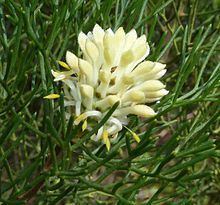Rank Species | ||
 | ||
Similar Petrophile, Isopogon anemonifolius, Hakea teretifolia, Petrophile sessilis, Isopogon anethifolius | ||
Petrophile pulchella, known as conesticks, is a common shrub of the family proteaceae found in eastern Australia. It is found growing on shallow sandstone soils, often in open forest or heathlands near the coast. It is also occasionally seen on the adjacent ranges.
Contents
Taxonomy
The original specimen was collected at Botany Bay, and the shrub first described by Heinrich Schrader and Johann Christoph Wendland in 1796 as Protea pulchella. The prolific botanist Robert Brown reclassified it in the new genus Petrophile. The specific epithet pulchella meaning “beautiful” is derived from Latin, although noted plant author John Wrigley feels it to be somewhat of a misnomer. Joseph Knight, who had propagated and cultivated it successfully in England by 1809, reported, "It has few claims to a place in our collections."
Description
Petrophile pulchella grows as a shrub, which can reach 3 metres (9.8 ft) high in sheltered locations and around 50 centimetres (20 in) in exposed heathland. The fine divided leaves average 4 to 10 centimetres (1.6 to 3.9 in) in length and are needle-shaped but soft rather than sharp-tipped. The new growth is glabrous (smooth). The cream-yellow inflorescences are roughly egg-shaped and appear in spring and summer. They are either sessile or on short stalks up to 1 centimetre (0.39 in) long. This distinguishes the species from P. pedunculata, which has its flowerheads on longer stalks 1 to 3 centimetres (0.39 to 1.18 in) long. The two other species in eastern Australia, P. canescens and P. sessilis, both have finely hairy new growth.
Distribution and habitat
Petrophile pulchella is found on nutrient poor sandstone soils in open sclerophyll forest with trees such as Sydney peppermint (Eucalyptus piperita), smooth-barked apple (Angophora costata) or more open woodland e.g. with scribbly gum (Eucalyptus sclerophylla), silvertop ash (E. sieberi) or heathland with shrubs such as mountain devil (Lambertia formosa), broad-leaved drumsticks (Isopogon anemonifolius) and paperbark tea-tree (Leptospermum trinervium).
Ecology
The shrubs are killed by fire and regenerate afterwards by canopy-stored seedbank. Plants can live up to 60 years in nature. A field study in Brisbane Water National Park found that Petrophile pulchella had greater reproductive output in areas that had had two short intervals of under seven years between fires, over areas that had had one short interval, and that plants in these latter areas had greater reproductive output than areas with no intervals under seven years between fires. Seeds can germinate up to 700 days after a bushfire, and it is possible that the seedbank could theoretically last up to 90 years between fires.
Native bees are possible pollinators of this species.
